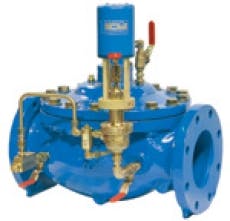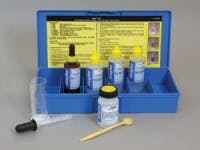By Marc Payot
Hydraulically actuated automatic control valves or regulators have been a mainstay in the waterworks industry for over 100 years. The primary benefit of using a hydraulically actuated valve is the use of line pressure as motive power to operate. Whether used to control pressure, flow or level, these valves operate without the need for external for external pressures and/or electricity.
However, these control valves are closed-loop systems. The main valve is controlled by a pilot that compares its spring setting (set-point) to the process variable (ie, pressure, flow, and/or level). As the process variable changes, the pilot senses the change and compensates to keep the process variable as close to the desired set-point as possible. As such, these valves are single set-point control valves, and a set-point change will require operators to change the spring setting of the pilot.
As the waterworks industry grows and systems become more complicated, the need to have multiple set-points and the ability to remotely change set-points is becoming necessary. For pressure management applications, downstream pressures need to be lowered during periods of low flows to reduce leakage. Operators often need to change process variables as conditions change in the system. For example, on a tank fill application, operators may want to switch the valve to pressure sustaining to maintain a minimum line pressure.
Whatever the application/case may be, if versatility is required and electricity is available, there are two ways to effectively control a diaphragm valve: solenoid control and motorized actuation of the pilot.
Solenoid Control
The principle operation of a hydraulically operated, diaphragm actuated control valve is to control the pressure on the control chamber. Increasing the pressure on the actuator closes the valve and decreasing the pressure opens the valve.
A solenoid uses a similar principle but operates on establishing a hydraulic lock. Water is an incompressible fluid and the volume of the control chamber is proportional to the valve position. If the control chamber is full of water, the valve is fully closed. If the control chamber is empty, then the valve is fully open. Of course, the statement can be said assuming the valve has sufficient available differential pressure to operate.
Solenoids are used because they are the most efficient devices in terms of cost and simplicity in the market today in actuating a valve. There are numerous manufacturers and they are readily available.
Control Valves with Solenoid Overrides
If control valves with hydraulic control systems require shut-off, a solenoid to isolate the pilot from the process can be employed to act as an override. Selecting the solenoid to be used will depend on the de-energized state of the valve. For example, a pressure reducing valve that fails closed on power failure uses a Normally Open solenoid.
Control Valves with Two Pilots (Solenoid Selectable)
If a control valve is required to have two set-points only, a solenoid can be employed to select between two pilots.
On/Off Non-Modulating Solenoid Control Valves
These valves employ a three-way solenoid and will either pressurize the control chamber or relieve it. This type of valve has two positions only: fully open or fully closed. Applications for this valve type includes: on/off level control, sprinkler systems, and can be used to flush stagnant water in a pipe.
Modulating Solenoid Control Valves
These valves employ two, two-way solenoids that in turn establish a hydraulic lock on the control chamber. The volume of the control chamber is directly proportional to valve position. By adding or relieving the existing volume of water in the control chamber, the valve can be positioned from 0% to 100% open. Using this type of control valve as the final control element, a process control system can be used to pulse the appropriate solenoid so that the process variable is regulated as close to the set-point as possible.
For this type of valve, the process control system and feedback transmitters are the key. The valve is now the final control element that manipulates the valve position, pressure, flow, and/or level. Depending on the feedback transmitters and the process control system, multiple process variables can be controlled with only one valve.
For example: operators require a control valve that will control flow into a reservoir and shutdown on high level. In addition, the valve shall monitor the upstream pressure of the line and modulate to make sure that there is sufficient line pressure and will prevent it from dropping further. Furthermore, when the reservoir is being by-passed due to maintenance, the valve controls downstream pressure and limits flow into the system.
With the example, a single dual solenoid control valve can be used to manipulate multiple processes. The benefit of having an electronic control system is that the operators can remotely change the process based on the conditions and allow them to monitor the process variables in real time.
Motorized Pilot Actuation
With dual solenoid control, the valve’s function is reduced to being a final control element. Without a control system to actuate the solenoids or transmitters, the valve cannot do any useful function. In case of power failure and depending on the orientation of the solenoids, the valve will merely fail open, fail close, or fail in the last position. To operate the valve, manual actuation is required.
For many years these control valves were controlled by pilots. The valve together with the pilots makes a closed loop system. The pilot acts as the control system and feedback to control the valve, and this allows the valve system to be completely automatic.
When changing a set-point, an operator is required to turn the pilot’s adjusting screw. If operators need to remotely change the set-point of the pilot a multi-turn motorized actuator can be used.
With each pilot there is a fixed change in set-point per turn of the screw. This linear relation to change in set-point per turn is surprisingly accurate and the linear relationship can be programmed in a multi-turn actuator. Using an analog signal, operators can now remotely change the set-point of the valve. In case of power failure, the valve will control its last set-point and will not fail open, close, or last position as is the case with a dual solenoid valve.
About the Author: Marc Payot is an Electronics Instrumentation Technician & Customer Service Representative at Singer Valve Inc. He is responsible for designing, building and programming control panels to suit customer needs. He also provides technical support and in-field support such as commissioning, field start-up, and training on electronic valves.






